Effects of Drought in East and Sub-Saharan Africa
VerifiedAdded on 2023/04/22
|8
|1837
|394
AI Summary
This write-up analyzes the effects of drought in East and Sub-Saharan Africa, the relationship between environmental factors and conflict, and the impact of climate change on agriculture and forests. It also provides recommendations to control the spread of drought.
Contribute Materials
Your contribution can guide someone’s learning journey. Share your
documents today.
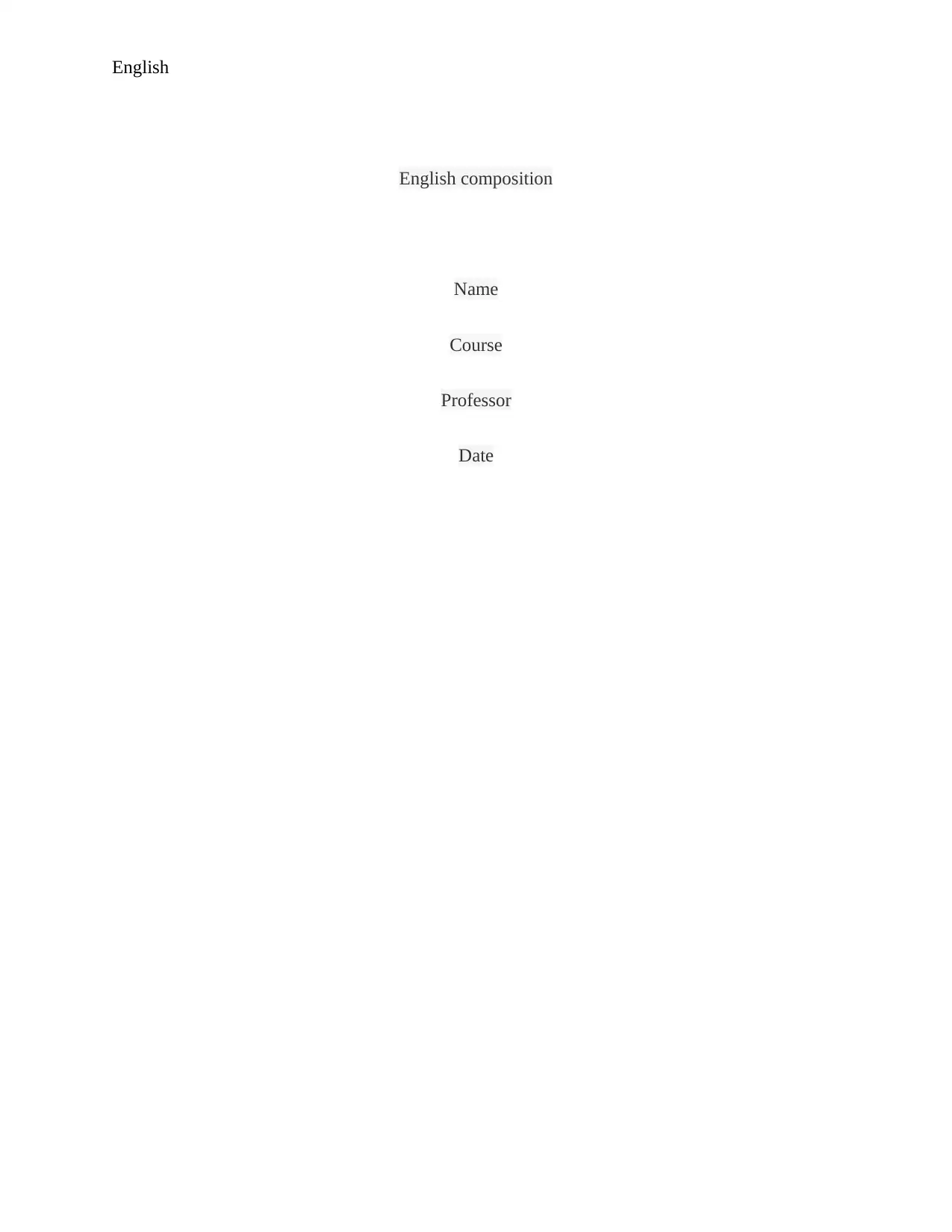
English
English composition
Name
Course
Professor
Date
English composition
Name
Course
Professor
Date
Secure Best Marks with AI Grader
Need help grading? Try our AI Grader for instant feedback on your assignments.
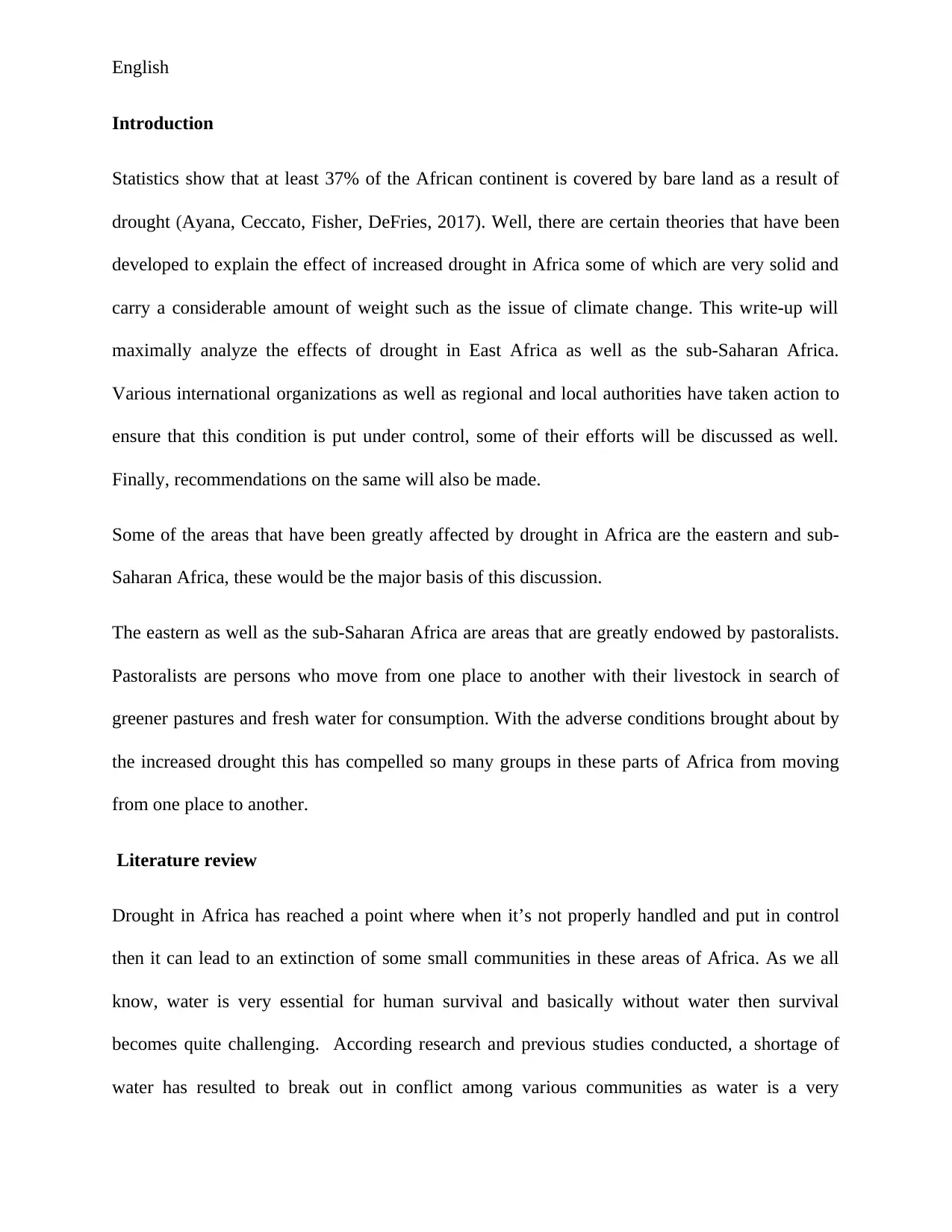
English
Introduction
Statistics show that at least 37% of the African continent is covered by bare land as a result of
drought (Ayana, Ceccato, Fisher, DeFries, 2017). Well, there are certain theories that have been
developed to explain the effect of increased drought in Africa some of which are very solid and
carry a considerable amount of weight such as the issue of climate change. This write-up will
maximally analyze the effects of drought in East Africa as well as the sub-Saharan Africa.
Various international organizations as well as regional and local authorities have taken action to
ensure that this condition is put under control, some of their efforts will be discussed as well.
Finally, recommendations on the same will also be made.
Some of the areas that have been greatly affected by drought in Africa are the eastern and sub-
Saharan Africa, these would be the major basis of this discussion.
The eastern as well as the sub-Saharan Africa are areas that are greatly endowed by pastoralists.
Pastoralists are persons who move from one place to another with their livestock in search of
greener pastures and fresh water for consumption. With the adverse conditions brought about by
the increased drought this has compelled so many groups in these parts of Africa from moving
from one place to another.
Literature review
Drought in Africa has reached a point where when it’s not properly handled and put in control
then it can lead to an extinction of some small communities in these areas of Africa. As we all
know, water is very essential for human survival and basically without water then survival
becomes quite challenging. According research and previous studies conducted, a shortage of
water has resulted to break out in conflict among various communities as water is a very
Introduction
Statistics show that at least 37% of the African continent is covered by bare land as a result of
drought (Ayana, Ceccato, Fisher, DeFries, 2017). Well, there are certain theories that have been
developed to explain the effect of increased drought in Africa some of which are very solid and
carry a considerable amount of weight such as the issue of climate change. This write-up will
maximally analyze the effects of drought in East Africa as well as the sub-Saharan Africa.
Various international organizations as well as regional and local authorities have taken action to
ensure that this condition is put under control, some of their efforts will be discussed as well.
Finally, recommendations on the same will also be made.
Some of the areas that have been greatly affected by drought in Africa are the eastern and sub-
Saharan Africa, these would be the major basis of this discussion.
The eastern as well as the sub-Saharan Africa are areas that are greatly endowed by pastoralists.
Pastoralists are persons who move from one place to another with their livestock in search of
greener pastures and fresh water for consumption. With the adverse conditions brought about by
the increased drought this has compelled so many groups in these parts of Africa from moving
from one place to another.
Literature review
Drought in Africa has reached a point where when it’s not properly handled and put in control
then it can lead to an extinction of some small communities in these areas of Africa. As we all
know, water is very essential for human survival and basically without water then survival
becomes quite challenging. According research and previous studies conducted, a shortage of
water has resulted to break out in conflict among various communities as water is a very
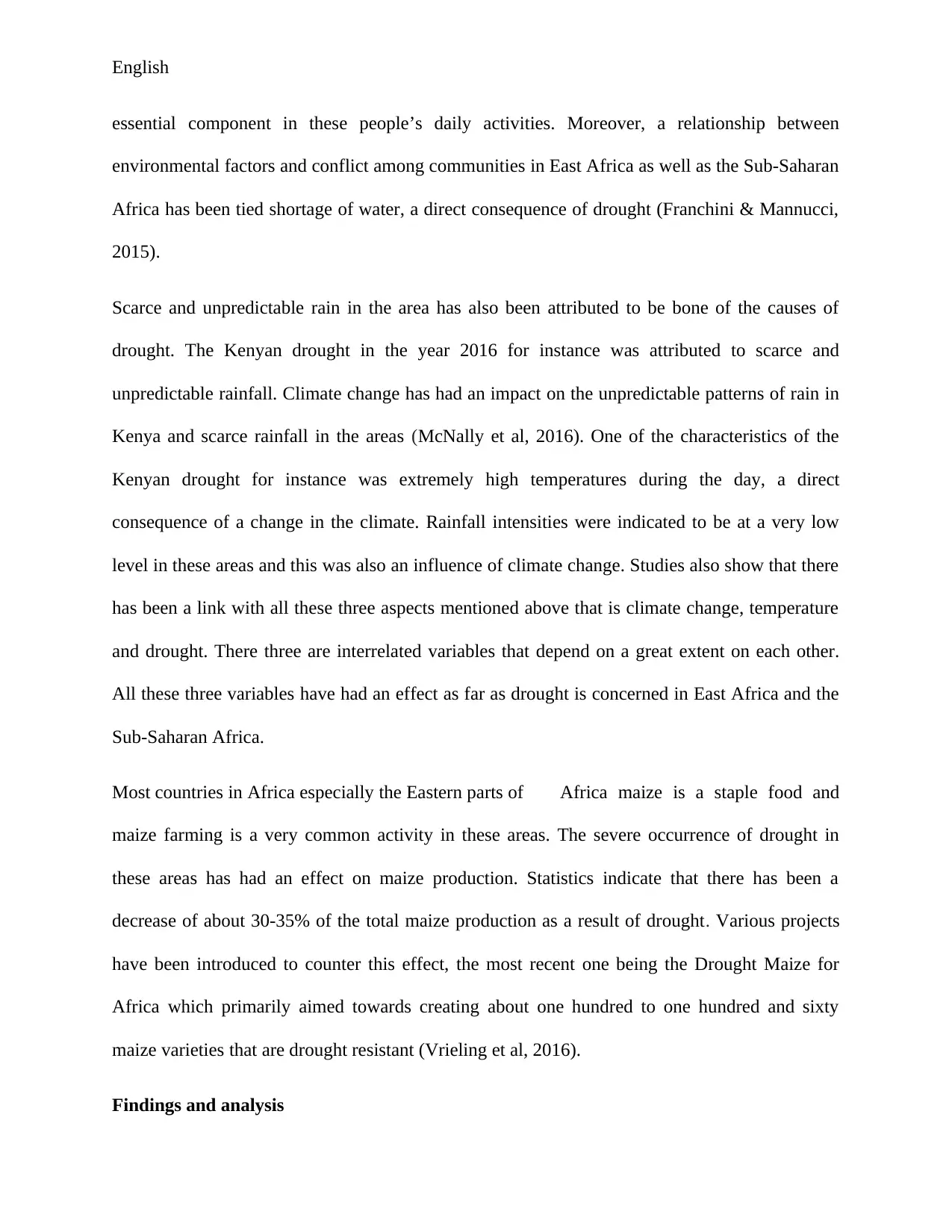
English
essential component in these people’s daily activities. Moreover, a relationship between
environmental factors and conflict among communities in East Africa as well as the Sub-Saharan
Africa has been tied shortage of water, a direct consequence of drought (Franchini & Mannucci,
2015).
Scarce and unpredictable rain in the area has also been attributed to be bone of the causes of
drought. The Kenyan drought in the year 2016 for instance was attributed to scarce and
unpredictable rainfall. Climate change has had an impact on the unpredictable patterns of rain in
Kenya and scarce rainfall in the areas (McNally et al, 2016). One of the characteristics of the
Kenyan drought for instance was extremely high temperatures during the day, a direct
consequence of a change in the climate. Rainfall intensities were indicated to be at a very low
level in these areas and this was also an influence of climate change. Studies also show that there
has been a link with all these three aspects mentioned above that is climate change, temperature
and drought. There three are interrelated variables that depend on a great extent on each other.
All these three variables have had an effect as far as drought is concerned in East Africa and the
Sub-Saharan Africa.
Most countries in Africa especially the Eastern parts of Africa maize is a staple food and
maize farming is a very common activity in these areas. The severe occurrence of drought in
these areas has had an effect on maize production. Statistics indicate that there has been a
decrease of about 30-35% of the total maize production as a result of drought. Various projects
have been introduced to counter this effect, the most recent one being the Drought Maize for
Africa which primarily aimed towards creating about one hundred to one hundred and sixty
maize varieties that are drought resistant (Vrieling et al, 2016).
Findings and analysis
essential component in these people’s daily activities. Moreover, a relationship between
environmental factors and conflict among communities in East Africa as well as the Sub-Saharan
Africa has been tied shortage of water, a direct consequence of drought (Franchini & Mannucci,
2015).
Scarce and unpredictable rain in the area has also been attributed to be bone of the causes of
drought. The Kenyan drought in the year 2016 for instance was attributed to scarce and
unpredictable rainfall. Climate change has had an impact on the unpredictable patterns of rain in
Kenya and scarce rainfall in the areas (McNally et al, 2016). One of the characteristics of the
Kenyan drought for instance was extremely high temperatures during the day, a direct
consequence of a change in the climate. Rainfall intensities were indicated to be at a very low
level in these areas and this was also an influence of climate change. Studies also show that there
has been a link with all these three aspects mentioned above that is climate change, temperature
and drought. There three are interrelated variables that depend on a great extent on each other.
All these three variables have had an effect as far as drought is concerned in East Africa and the
Sub-Saharan Africa.
Most countries in Africa especially the Eastern parts of Africa maize is a staple food and
maize farming is a very common activity in these areas. The severe occurrence of drought in
these areas has had an effect on maize production. Statistics indicate that there has been a
decrease of about 30-35% of the total maize production as a result of drought. Various projects
have been introduced to counter this effect, the most recent one being the Drought Maize for
Africa which primarily aimed towards creating about one hundred to one hundred and sixty
maize varieties that are drought resistant (Vrieling et al, 2016).
Findings and analysis
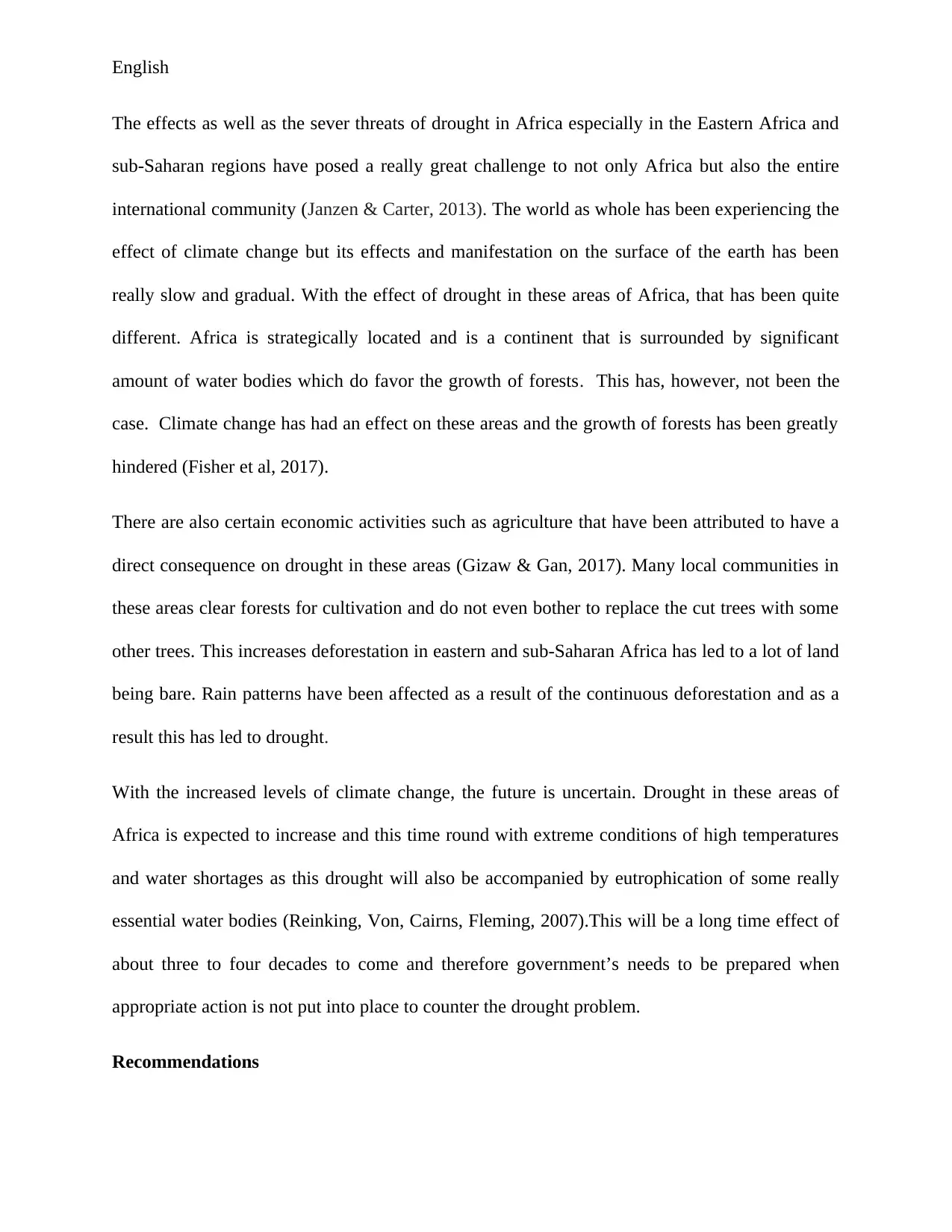
English
The effects as well as the sever threats of drought in Africa especially in the Eastern Africa and
sub-Saharan regions have posed a really great challenge to not only Africa but also the entire
international community (Janzen & Carter, 2013). The world as whole has been experiencing the
effect of climate change but its effects and manifestation on the surface of the earth has been
really slow and gradual. With the effect of drought in these areas of Africa, that has been quite
different. Africa is strategically located and is a continent that is surrounded by significant
amount of water bodies which do favor the growth of forests. This has, however, not been the
case. Climate change has had an effect on these areas and the growth of forests has been greatly
hindered (Fisher et al, 2017).
There are also certain economic activities such as agriculture that have been attributed to have a
direct consequence on drought in these areas (Gizaw & Gan, 2017). Many local communities in
these areas clear forests for cultivation and do not even bother to replace the cut trees with some
other trees. This increases deforestation in eastern and sub-Saharan Africa has led to a lot of land
being bare. Rain patterns have been affected as a result of the continuous deforestation and as a
result this has led to drought.
With the increased levels of climate change, the future is uncertain. Drought in these areas of
Africa is expected to increase and this time round with extreme conditions of high temperatures
and water shortages as this drought will also be accompanied by eutrophication of some really
essential water bodies (Reinking, Von, Cairns, Fleming, 2007).This will be a long time effect of
about three to four decades to come and therefore government’s needs to be prepared when
appropriate action is not put into place to counter the drought problem.
Recommendations
The effects as well as the sever threats of drought in Africa especially in the Eastern Africa and
sub-Saharan regions have posed a really great challenge to not only Africa but also the entire
international community (Janzen & Carter, 2013). The world as whole has been experiencing the
effect of climate change but its effects and manifestation on the surface of the earth has been
really slow and gradual. With the effect of drought in these areas of Africa, that has been quite
different. Africa is strategically located and is a continent that is surrounded by significant
amount of water bodies which do favor the growth of forests. This has, however, not been the
case. Climate change has had an effect on these areas and the growth of forests has been greatly
hindered (Fisher et al, 2017).
There are also certain economic activities such as agriculture that have been attributed to have a
direct consequence on drought in these areas (Gizaw & Gan, 2017). Many local communities in
these areas clear forests for cultivation and do not even bother to replace the cut trees with some
other trees. This increases deforestation in eastern and sub-Saharan Africa has led to a lot of land
being bare. Rain patterns have been affected as a result of the continuous deforestation and as a
result this has led to drought.
With the increased levels of climate change, the future is uncertain. Drought in these areas of
Africa is expected to increase and this time round with extreme conditions of high temperatures
and water shortages as this drought will also be accompanied by eutrophication of some really
essential water bodies (Reinking, Von, Cairns, Fleming, 2007).This will be a long time effect of
about three to four decades to come and therefore government’s needs to be prepared when
appropriate action is not put into place to counter the drought problem.
Recommendations
Secure Best Marks with AI Grader
Need help grading? Try our AI Grader for instant feedback on your assignments.
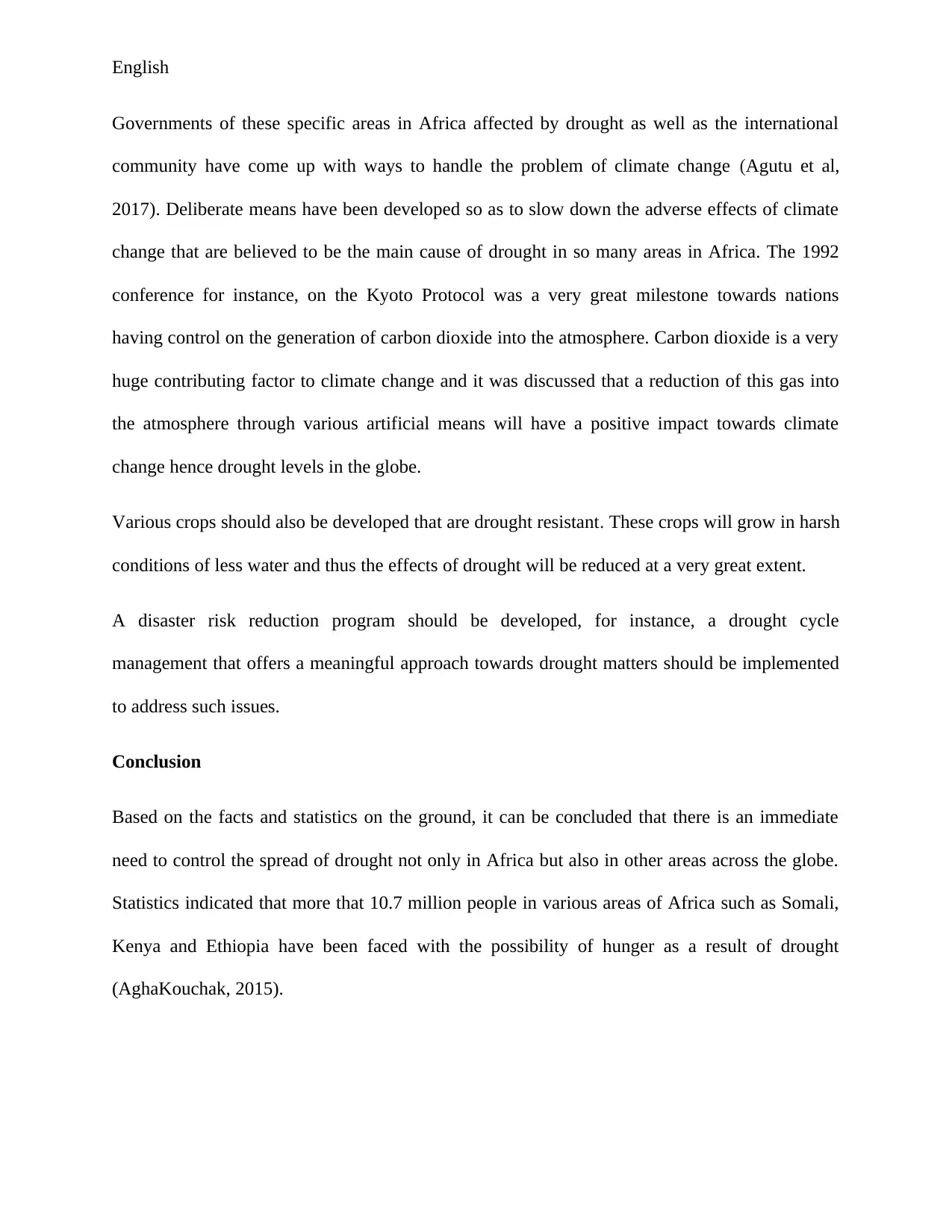
English
Governments of these specific areas in Africa affected by drought as well as the international
community have come up with ways to handle the problem of climate change (Agutu et al,
2017). Deliberate means have been developed so as to slow down the adverse effects of climate
change that are believed to be the main cause of drought in so many areas in Africa. The 1992
conference for instance, on the Kyoto Protocol was a very great milestone towards nations
having control on the generation of carbon dioxide into the atmosphere. Carbon dioxide is a very
huge contributing factor to climate change and it was discussed that a reduction of this gas into
the atmosphere through various artificial means will have a positive impact towards climate
change hence drought levels in the globe.
Various crops should also be developed that are drought resistant. These crops will grow in harsh
conditions of less water and thus the effects of drought will be reduced at a very great extent.
A disaster risk reduction program should be developed, for instance, a drought cycle
management that offers a meaningful approach towards drought matters should be implemented
to address such issues.
Conclusion
Based on the facts and statistics on the ground, it can be concluded that there is an immediate
need to control the spread of drought not only in Africa but also in other areas across the globe.
Statistics indicated that more that 10.7 million people in various areas of Africa such as Somali,
Kenya and Ethiopia have been faced with the possibility of hunger as a result of drought
(AghaKouchak, 2015).
Governments of these specific areas in Africa affected by drought as well as the international
community have come up with ways to handle the problem of climate change (Agutu et al,
2017). Deliberate means have been developed so as to slow down the adverse effects of climate
change that are believed to be the main cause of drought in so many areas in Africa. The 1992
conference for instance, on the Kyoto Protocol was a very great milestone towards nations
having control on the generation of carbon dioxide into the atmosphere. Carbon dioxide is a very
huge contributing factor to climate change and it was discussed that a reduction of this gas into
the atmosphere through various artificial means will have a positive impact towards climate
change hence drought levels in the globe.
Various crops should also be developed that are drought resistant. These crops will grow in harsh
conditions of less water and thus the effects of drought will be reduced at a very great extent.
A disaster risk reduction program should be developed, for instance, a drought cycle
management that offers a meaningful approach towards drought matters should be implemented
to address such issues.
Conclusion
Based on the facts and statistics on the ground, it can be concluded that there is an immediate
need to control the spread of drought not only in Africa but also in other areas across the globe.
Statistics indicated that more that 10.7 million people in various areas of Africa such as Somali,
Kenya and Ethiopia have been faced with the possibility of hunger as a result of drought
(AghaKouchak, 2015).
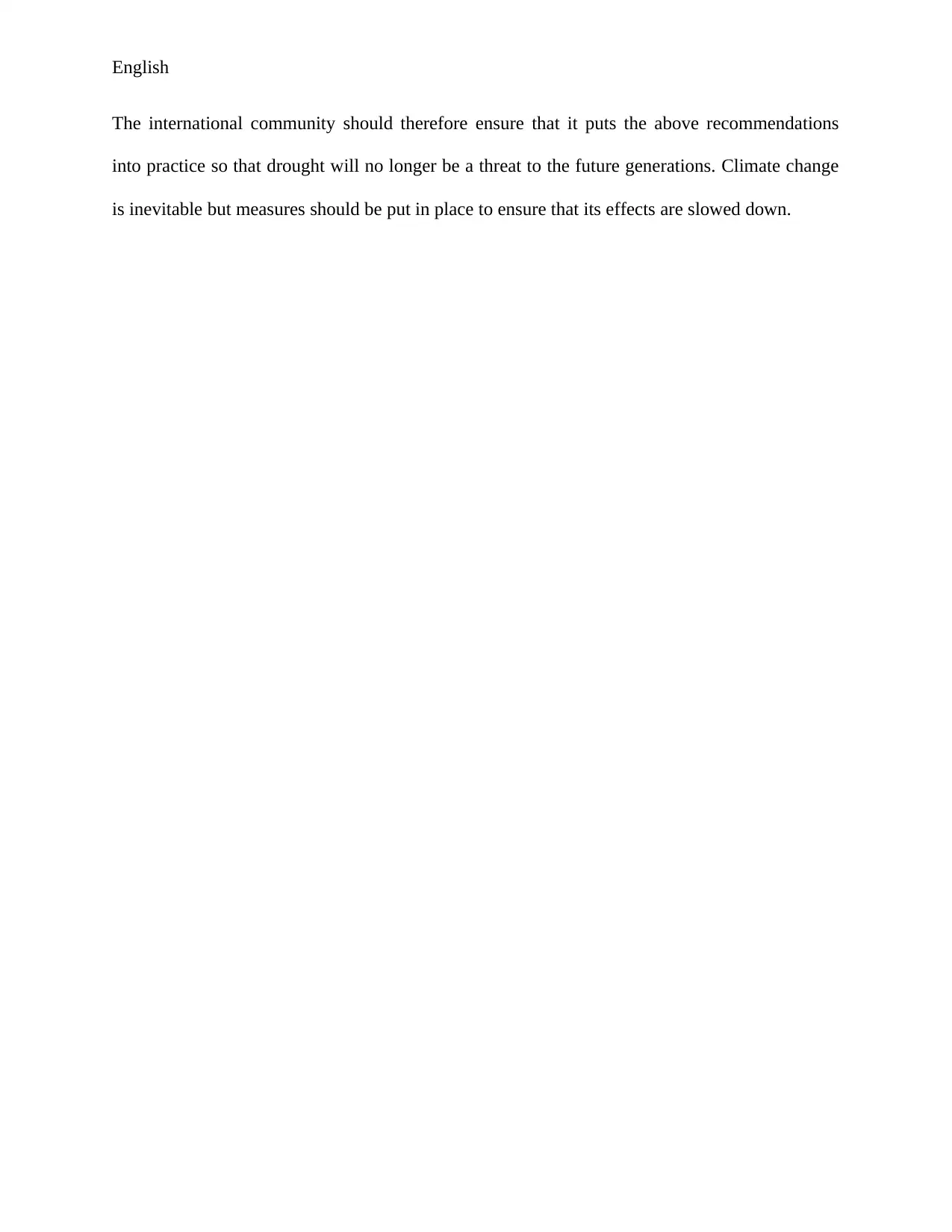
English
The international community should therefore ensure that it puts the above recommendations
into practice so that drought will no longer be a threat to the future generations. Climate change
is inevitable but measures should be put in place to ensure that its effects are slowed down.
The international community should therefore ensure that it puts the above recommendations
into practice so that drought will no longer be a threat to the future generations. Climate change
is inevitable but measures should be put in place to ensure that its effects are slowed down.

English
References
AghaKouchak, A. (2015). A multivariate approach for persistence-based drought prediction:
Application to the 2010–2011 East Africa drought. Journal of Hydrology, 526, 127-135
Agutu, N. O., Awange, J. L., Zerihun, A., Ndehedehe, C. E., Kuhn, M., & Fukuda, Y. (2017).
Assessing multi-satellite remote sensing, reanalysis, and land surface models' products in
characterizing agricultural drought in East Africa. Remote sensing of environment, 194,
287-302.
Ayana, E. K., Ceccato, P., Fisher, J. R., & DeFries, R. (2016). Examining the relationship
between environmental factors and conflict in pastoralist areas of East Africa. Science of
The Total Environment, 557, 601-611.
Fisher, M., Abate, T., Lunduka, R. W., Asnake, W., Alemayehu, Y., & Madulu, R. B. (2015).
Drought tolerant maize for farmer adaptation to drought in sub-Saharan Africa:
Determinants of adoption in eastern and southern Africa. Climatic Change, 133(2), 283-
299.
Franchini, M., & Mannucci, P. M. (2015). Impact on human health of climate changes.
European journal of internal medicine, 26(1), 1-5.
Gizaw, M. S., & Gan, T. Y. (2017). Impact of climate change and El Niño episodes on droughts
in sub-Saharan Africa. Climate Dynamics, 49(1-2), 665-682.
Janzen, S. A., & Carter, M. R. (2013). The impact of microinsurance on asset accumulation and
human capital investments: Evidence from a drought in Kenya. ILO Microinsurance
Innovation Facility.
References
AghaKouchak, A. (2015). A multivariate approach for persistence-based drought prediction:
Application to the 2010–2011 East Africa drought. Journal of Hydrology, 526, 127-135
Agutu, N. O., Awange, J. L., Zerihun, A., Ndehedehe, C. E., Kuhn, M., & Fukuda, Y. (2017).
Assessing multi-satellite remote sensing, reanalysis, and land surface models' products in
characterizing agricultural drought in East Africa. Remote sensing of environment, 194,
287-302.
Ayana, E. K., Ceccato, P., Fisher, J. R., & DeFries, R. (2016). Examining the relationship
between environmental factors and conflict in pastoralist areas of East Africa. Science of
The Total Environment, 557, 601-611.
Fisher, M., Abate, T., Lunduka, R. W., Asnake, W., Alemayehu, Y., & Madulu, R. B. (2015).
Drought tolerant maize for farmer adaptation to drought in sub-Saharan Africa:
Determinants of adoption in eastern and southern Africa. Climatic Change, 133(2), 283-
299.
Franchini, M., & Mannucci, P. M. (2015). Impact on human health of climate changes.
European journal of internal medicine, 26(1), 1-5.
Gizaw, M. S., & Gan, T. Y. (2017). Impact of climate change and El Niño episodes on droughts
in sub-Saharan Africa. Climate Dynamics, 49(1-2), 665-682.
Janzen, S. A., & Carter, M. R. (2013). The impact of microinsurance on asset accumulation and
human capital investments: Evidence from a drought in Kenya. ILO Microinsurance
Innovation Facility.
Paraphrase This Document
Need a fresh take? Get an instant paraphrase of this document with our AI Paraphraser
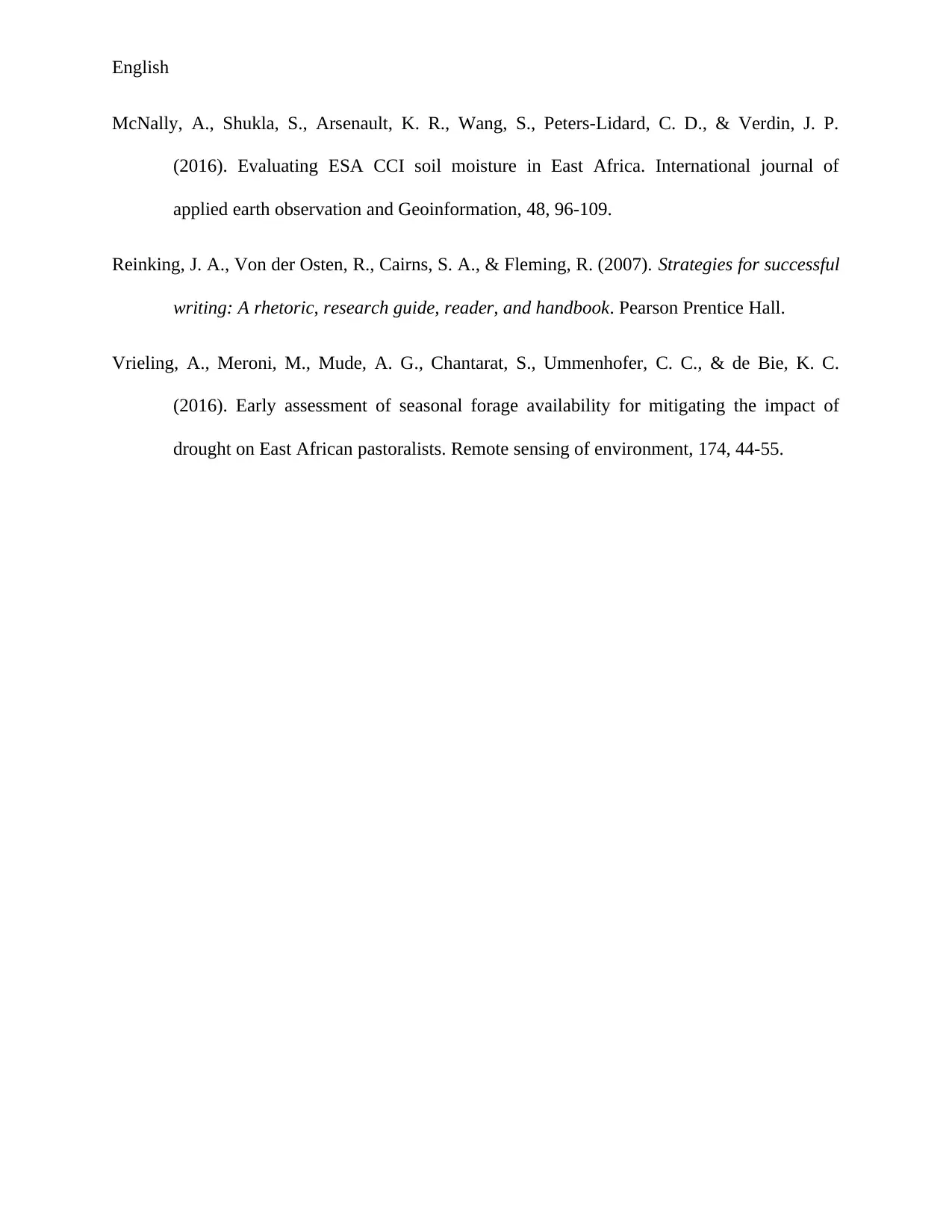
English
McNally, A., Shukla, S., Arsenault, K. R., Wang, S., Peters-Lidard, C. D., & Verdin, J. P.
(2016). Evaluating ESA CCI soil moisture in East Africa. International journal of
applied earth observation and Geoinformation, 48, 96-109.
Reinking, J. A., Von der Osten, R., Cairns, S. A., & Fleming, R. (2007). Strategies for successful
writing: A rhetoric, research guide, reader, and handbook. Pearson Prentice Hall.
Vrieling, A., Meroni, M., Mude, A. G., Chantarat, S., Ummenhofer, C. C., & de Bie, K. C.
(2016). Early assessment of seasonal forage availability for mitigating the impact of
drought on East African pastoralists. Remote sensing of environment, 174, 44-55.
McNally, A., Shukla, S., Arsenault, K. R., Wang, S., Peters-Lidard, C. D., & Verdin, J. P.
(2016). Evaluating ESA CCI soil moisture in East Africa. International journal of
applied earth observation and Geoinformation, 48, 96-109.
Reinking, J. A., Von der Osten, R., Cairns, S. A., & Fleming, R. (2007). Strategies for successful
writing: A rhetoric, research guide, reader, and handbook. Pearson Prentice Hall.
Vrieling, A., Meroni, M., Mude, A. G., Chantarat, S., Ummenhofer, C. C., & de Bie, K. C.
(2016). Early assessment of seasonal forage availability for mitigating the impact of
drought on East African pastoralists. Remote sensing of environment, 174, 44-55.
1 out of 8
Related Documents
Your All-in-One AI-Powered Toolkit for Academic Success.
+13062052269
info@desklib.com
Available 24*7 on WhatsApp / Email
![[object Object]](/_next/static/media/star-bottom.7253800d.svg)
Unlock your academic potential
© 2024 | Zucol Services PVT LTD | All rights reserved.





